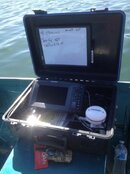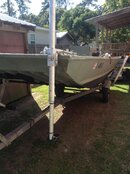Mark Michaud SELAUSAR
Contributor
You can buy a Humminbird. Mine is an 898c SI. I have 2 options for my transducer. 1 is on a moving post. This works much better than the trolling motor mount they sell. If on a river, lake or flats seas it works very well and motor "noise" does not interfere. I also built a tow fish. I can hang it over the side, off of the back or wherever where seas are a bit more rough. I am almost done with a larger and much heavier fish for flying the fish below about 20'. The one pictured will not stay down as it is too light (20 lbs). For SAR this is an ideal tool. For commercial surveying it is not. The first image is from my unit on the plane crash search. The second is from a $1,000,000 survey boat. My video of this is identical to the commercial image. I have less than $2000.00 in my unit. Most SAR searches are in 50' or less unless offshore. I extended my cables and can drop my fish to 130' giving me a 180' depth range with the heavier fish. again, it is only a tool but a good one nonetheless.













